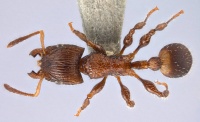Dilobocondyla carinata
| Dilobocondyla carinata | |
|---|---|

| |
| Scientific classification | |
| Kingdom: | Animalia |
| Phylum: | Arthropoda |
| Class: | Insecta |
| Order: | Hymenoptera |
| Family: | Formicidae |
| Subfamily: | Myrmicinae |
| Tribe: | Crematogastrini |
| Genus: | Dilobocondyla |
| Species: | D. carinata |
| Binomial name | |
| Dilobocondyla carinata Zettel & Bruckner, 2013 | |
Nothing is known about the biology of Dilobocondyla carinata.
Identification
Zettel and Bruckner (2013) - Worker: Brown; with yellow mark on gaster tergite 1. Posterior margin of head concave. Frontal carinae strong, reaching posterior corners of head. Sculpture of head and mesosoma coarse; interspaces mostly shiny. Petiole with transverse carina. Postpetiole dorsally regularly striated.
Dilobocondyla carinata can be immediately distinguished from all congeners by the petiole bearing a dorsal transverse ridge. The presence of this ridge results in a low PtI of 167, although the petiole is slender as in other species of the D. chapmani group.
Keys including this Species
Distribution
Latitudinal Distribution Pattern
Latitudinal Range: 13.4° to 13.4°.
| North Temperate |
North Subtropical |
Tropical | South Subtropical |
South Temperate |
- Source: AntMaps
Distribution based on Regional Taxon Lists
Indo-Australian Region: Philippines (type locality).
Distribution based on AntMaps
Distribution based on AntWeb specimens
Check data from AntWeb
Countries Occupied
| Number of countries occupied by this species based on AntWiki Regional Taxon Lists. In general, fewer countries occupied indicates a narrower range, while more countries indicates a more widespread species. |

|
Estimated Abundance
| Relative abundance based on number of AntMaps records per species (this species within the purple bar). Fewer records (to the left) indicates a less abundant/encountered species while more records (to the right) indicates more abundant/encountered species. |

|
Biology
Castes
Known only from the worker caste.
Nomenclature
The following information is derived from Barry Bolton's Online Catalogue of the Ants of the World.
- carinata. Dilobocondyla carinata Zettel & Bruckner, 2013: 145, figs. 4, 10, 16 (w.) PHILIPPINES (Mindoro I.).
- Type-material: holotype worker, 1 paratype worker.
- Type-locality: holotype Philippines: Oriental Mindoro, Calapan City, Parang, 26-27.v.2008, no. P290 (C. Pangantihon); paratype with same data.
- Type-depositories: USCC (holotype); HSZC (paratype).
- Status as species: Chen, et al. 2019: 137 (in key).
- Distribution: Philippines (Mindoro).
Unless otherwise noted the text for the remainder of this section is reported from the publication that includes the original description.
Description
Worker
Holotype: TL 4.35; HW 1.09; HL 1.14; CI 96; SL 0.70; SI 64; PnW 0.72; PtL 0.51; PtH 0.31; PtW 0.24; PtI 167; PpL 0.37; PpH 0.38; PpW 0.37. Paratype: TL 4.20; HW 1.06; HL 1.11; CI 95; SL 0.68; SI 64; PnW 0.71; PtL 0.50; PtH 0.30; PtW 0.24; PtI 167; PpL 0.36; PpH 0.37; PpW 0.37.
Colour: Head with mandibles, mesosoma and legs, petiole and postpetiole brown; dorsum of head, sides of mesosoma, and node of petiole slightly infuscated; trochanters and distal tarsomeres pale. Gaster blackish brown, tergite 1 with yellow mark anteriorly. Antenna dark brown except yellow scape.
Structures: Head with almost regular coarse striation, except more or less vermiculated rugae behind eyes. Interspaces shiny, almost smooth, at most with very superficial microsculpture. Posterior margin of head concave; hind corners angular. Frontal carinae and antennal scrobes reaching hind corners. Clypeus with five longitudinal rugae; interspaces weakly micro-reticulated.
Mesosoma almost entirely reticulated; coarse rugae forming large meshes; an imaginary line between pronotal corners transecting nine meshes; meso- and metapleura smooth, as shiny as all interspaces. Petiole dorsally unsculptured, laterally with longitudinal rugae; its outline in lateral view unique, anteriorly and posteriorly slender, at mid-length raised to a dorsal transverse ridge; anterodorsal and posterodorsal outline slightly concave; anteroventral tooth small, triangular. Postpetiole in lateral aspect subtriangular, with narrowly rounded apex; both anterodorsal and posterodorsal surface with regular coarse striation. Gaster tergite 1 at base with very dense fine striation that gradually changes to a fine reticulum where the yellow mark ends.
Type Material
- Holotype, worker, Mindoro Island, Oriental Mindoro Province, Calapan City, barangay Parang, ca. 50 m a.sl., Philippines, 13°24′N 121°12′E / 13.4°N 121.2°E, 26-27 May 2008, C. Pangantihon, San Carlos University, Cebu City.
- Paratype, 1 worker, Mindoro Island, Oriental Mindoro Province, Calapan City, barangay Parang, ca. 50 m a.sl., Philippines, 13°24′N 121°12′E / 13.4°N 121.2°E, 26-27 May 2008, C. Pangantihon, H. Zettel Collection.
Etymology
The Latin adjective carinatus (= keeled) refers to the characteristic carina on the petiole.

